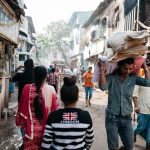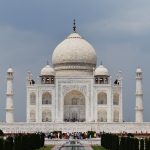For the past two years, I have had the privilege of working in Dharavi: the heart of Mumbai, its center of small scale enterprise, and “one of the largest ‘slums’ in Asia”. Dharavi is an incredibly unique area that outsiders rarely get the opportunity to work in and learn from for such an extended period of time. It is an organically built neighborhood comprised of over 80 different communities that was born out of necessity and now houses up to one million people (who speak over 30 languages and follow six religions) and 15,000 small scale industries.
While slums are an all too common sight in the modern world, Dharavi is unique in its scale and ability to integrate work and living in such tight proximity – it is 20 times as dense as the rest of Mumbai. When people visit the area two things stand out: the evident happiness of many of the people in the residential sections and the level of industry. While these are important takeaways that fly in the face of common perceptions of low income areas and people, Dharavi has much more to teach the world. For the past two years, I have reflected on two central questions: where does that ‘happiness’ come from and why do slums exist? To answer these questions, I drew on conversations with community members, its recorded history and elements of philosophy, economics, and urbanization. Using Dharavi as an example, in this article I will attempt to explain what I have learned.
First, I have learned that happiness should be decoupled from money and material possessions. While this might sound obvious, it is an idea that is woefully absent in practice, especially in economically developed countries where people work nearly every waking hour, neglecting friends and family, to achieve status and money through their careers. The residential area of Dharavi illustrates that once basic needs (food, water, and shelter) have been taken care of, money has little impact on happiness. While an abundance of issues continue to persist, these needs have been met and one is immediately struck by the happiness among the community when visiting and talking with them.

If money and material possessions don’t lead to happiness, then there must be something else that does. Early in my time in Mumbai, as I traveled from my work in Dharavi to my apartment in Bandra West (a relatively affluent suburb of Mumbai), I was struck by the transformation in community that I saw. I would leave Kumbharwada (potter’s colony) in Dharavi in the evening, where the small lanes would be crowded with people sitting together, sipping chai, eating pani puri from a passing vendor, or idly talking. When I arrived to my apartment I would typically walk past a neighbor who would not even look at me — let alone say ‘hello’ — then I would climb my steps, past closed doors, and into my apartment. If I had lived in the apartment for the past 50 years I’m sure I would know my neighbors better, but not a single neighbor welcomed me or introduced themselves when I moved in. I think this is indicative of my apartment building’s community. I was, however, approached by a neighbor once. He knocked on my door to inform me that water from my air conditioner was dripping on his motorbike below and that I should fix it immediately. When I compare the situation to America, the contrast was even starker: instead of people closed off in apartments, the suburbanization of America combined with the mass proliferation of the car has led to a systematic collapse of neighborhood communities. Suburbanites are closed off from their neighbors as they move between locations in their cars and then move directly into their houses through their garages. Americans no longer have occasion to even greet their neighbors. While suburban living has been touted as the ‘American Dream’ over the past half century, I think we have lost something significant in the process.
The daily transformation that I witnessed between Dharavi and my apartment building in Bandra has taught me that community and social ties are central to happiness. It’s a point that may seem obvious and indeed it has been recognized by philosophers through the ages, but it is not something that we consciously work towards. And it’s easy to understand why: we are constantly bombarded by advertising that tells us happiness is just one purchase away. But this experiential learning over the past two years has driven these lessons home so strongly that the advertising gimmicks of Coca Cola and Apple now appear hollow.

While my first lesson forced me to consider life philosophy, my second key takeaway about the origins of slums involved looking at history and economics. Walking through Dharavi each day and thinking about where I grew up (an upper class neighborhood in central Seattle) and my apartment in Bandra West, I was unable rationalize the discrepancy. How could economic inequality to this degree exist? Guilt and frustration drove me to try and find an answer. I knew that the only difference between me and someone living in Dharavi was ‘the lottery of birth’; the feeling of injustice was overwhelming.
While people who visit Dharavi for the first time are struck by the level of industry, we shouldn’t be all that surprised; most people from economically developed countries are aware of where our products come from and where our waste goes (in today’s globalized world even our plastic gets sent around the world to places like Dharavi). The production of our products and the disposal of our waste is dirty business and it disproportionately affects the poor. Typically the middle and upper class public are nicely shielded off from these processes. But witnessing this grave injustice almost daily made it impossible to ignore. Looking into the economic and historical factors that created Dharavi was very uncomfortable; the answer implicates us all.
When the British acquired Bombay it was a series of seven islands and could hardly be considered a city. The British’s first settlement was the area of Mumbai that is called ‘Fort’ today and many of its buildings still stand. The wall that surrounded it, however, does not. The construction of their settlement required cheap labor from the countryside and accommodation wasn’t provided. As a result squatter settlements were set up outside the Fort walls. These could be called the first slums of Mumbai. As the city expanded outwards from Fort, the slums were destroyed and the inhabitants moved further afield. Some moved well outside the city to an area of mangroves. Over the past 150 years the swamp has been completely paved over, homes have been built and lived in for multiple generations, and industries have been set up. This is the brief history of Dharavi: it turned uninhabitable mangroves into homes for hundreds of thousands. But Dharavi provides much more than just housing. Its residents are the lifeblood of Mumbai: mill workers, policemen, maids, taxi drivers, office workers, engineers and doctors, just to name a few. Furthermore, industries have been set up to provide India with pottery and food and the rest of the world with leather products and recycling facilities. But the city continued to expand and what was once a distant mangrove in the suburbs is now prime central real estate in India’s financial capital. Developers are salivating. They need to somehow remove the hundreds of thousands of people because the land that they transformed is now worth a fortune. While Dharavi has most likely survived so long because of the value of its workforce, real estate prices have risen to such an extent in Mumbai that this is no longer enough to stave off ‘redevelopment.’
The history of Mumbai and Dharavi is the story of capitalism and globalization and it has been told many times over the past several centuries in cities all over the world. Dharavi illustrates two critical points about how globalized capitalism works today. First, its factories reveal where and how our products are produced. Two of capitalism’s fundamental requirements are cheap labor and places to invest surplus capital. In a globalized economy in which capital can move freely, it will go wherever the returns are highest. Over the past century, capitalists found an abundant source of cheap labor in less economically developed countries such as India and Dharavi (although in Dharavi’s case that is changing). Companies can subcontract production to areas like Dharavi, where wages are low and not directly implicate themselves in the human right violations that occur. Villagers from around India (typically from poorer states like Bihar, Uttar Pradesh and Jharkhand), desperate for work, leave their families and travel to Mumbai to work in the industrial area of Dharavi for eight months at a stretch. During that time, they work 12 hours a day and sleep in (or on top of) the factory. A logo is attached to the products elsewhere and they are shipped to economically developed countries to sell. This is the story of almost every product next to you right now, including the device you are reading this on.

Second, Dharavi tells the dark side of the story of ‘urbanization’. Investing in urban development has historically been one of the primary answers to the quandary of where to invest surplus capital. These massive investments require a huge amount of labor, which is typically imported from other areas. The result is temporary settlements that become permanent when the migrant workers are left out in the cold (or the heat in Mumbai’s case) with no work after the construction is completed. Urbanization also signals the promise of economic development for hopeful migrants and they arrive in droves (about 800 migrants arrive in Mumbai, India’s ‘City of Dreams’, each week). With nowhere to live, most start out on the streets or if they’re lucky, in a slum or a factory floor. The final cruel twist of the knife comes when the developers (whose original investments created the slums) deem the squatter’s land valuable and convince the public of a need to beautify and ‘redevelop’ the city. This story has unfolded in nearly every major modern metropolis. I learned the exact same story in the past two cities I lived in: Paris and its ‘Haussmannization’ and the meteoric rise of South Korea and Seoul. While this happened centuries ago in Paris and decades ago in Seoul, it is happening before our eyes in Mumbai. How the inhabitants in Dharavi will be treated through this process is still unknown but the fact that the redevelopment plans were created with little or no input from them is not a good sign.
Now, it must be said that some would look at Dharavi in a very different light. They hold up places like Dharavi as an example of how the system is working: people are climbing their way out of poverty. My response is, first, shame on anyone who believes this. No system should be claimed to be working properly if it requires fellow humans to leave their families, travel to an unknown city, and work under inhumane conditions (the average lifespan in the industrial area of Dharavi is 55 years) for next to nothing. Second, this ‘functioning system’ is what created poverty as we know it today in the first place — an uncomfortable truth that everyone from Bill and Melinda Gates to the UN prefer to ignore. The people of Dharavi have nothing to be ashamed of, but those of us benefiting from today’s globalized society absolutely do.

While I think this story of Dharavi reveals the worst elements of humanity, it also shows our best elements. It is clear that no one should have to live and work under these circumstances (India’s constitution and the UN’s Declaration of Human Rights plainly say so), but the response to these adverse conditions is equal parts humbling and inspiring and gives me hope for the future. While Dharavi as a whole illustrates the dark direction capitalism can take, its people demonstrate resilience, ingenuity, and hope in the face of its daunting challenges. Dharavi was built out of a swamp with no central planning and it meets the basic needs of hundreds of thousands of people and ingeniously intertwines living and working spaces. It has long been the object of study by urban planners and it might hold the key to managing urbanization over the next 50 years (by 2050 70% of the world will live in cities).
Dharavi is much more than a slum or a busy industrial area; it is a neighborhood that illuminates the essential ingredients of happiness and exposes the unjust system of which we are all a part. The achievements of the people of Dharavi should be celebrated (and learned from) but at the same time, we need to work towards a system in which everyone has secure and adequate housing, sanitation facilities, and access to quality education and health care. This means that, first, we need to hold our companies accountable for their supply chains. We vote everyday with our wallets and companies are listening – we must vote wisely. Second, we must push for a stronger social safety net (in India, the USA, and everywhere in between). We must build a floor below which no fellow humans are forced to live. Finally, we can join the growing green wave and invest in clean energy and technology which simultaneously provides good, clean jobs and builds a more sustainable future. To accomplish these three goals, the public and private sectors must join the cause and it will take strong urging from citizens everywhere to get them to do so. The story of Dharavi is one of a fundamentally unjust system; I plan to use this awareness to work towards a more equitable future. I hope you will join me.
About the author: Nick Hamilton worked with Reality Tours & Travel as Marketing Director from February 2014 until recently, when he left his role to pursue further education.




